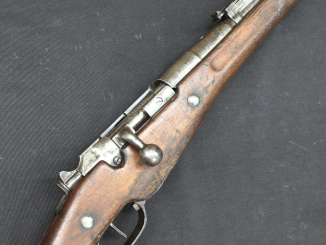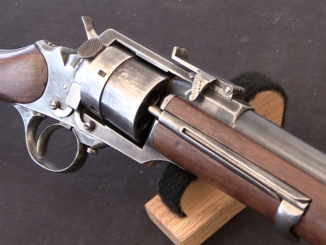Preorders now open for my book, Chassepot to FAMAS: French Military Rifles 1866-2016! Get your copy here!
After the adoption of the single-shot Gras rifle in 1874, attitudes towards repeating rifles began to shift in the French military. The Battle of Plevna had shown that regardless of their hypothetic detriments, repeating rifles could substantially magnify a force’s firepower and allow a smaller force to defeat a larger one. In 1878 the French Navy had adopted a tube-magazine Kropatschek rifle, and the head of the Chatellerault Arsenal tool shop, Albert Close, spent several years improving it and adapting it for French production.
He presented his completed rifle in 1883, and it was adopted and put into mass production. Both the Chatellerault and St Etienne arsenals would build Mle 1884 rifles, although they both ceased in 1886 when the Lebel and its smokeless powder changed the whole face of military small arms. A total of about 83,000 Model 1884 rifles were made, and they would serve as the basis for the 1885 and by extension the Lebel itself.




I heard the receivers and bolts on the later guns were strong enough to handle mildly loaded smokeless cartridges, but that’s just hearsay. “Mild” loads don’t equate to “non lethal,” anyway. I could be wrong.
“heard the receivers and bolts on the later guns were strong enough to handle mildly loaded smokeless cartridges, but that’s just hearsay”
Well, I would say any originally black-powder rifle cartridge could be loaded with small enough charge of smokeless powder to NOT cause catastrophic failure in 1 shot.
Though this solution is far from optimal, as relatively big free (unused) space remain inside.
True, a black powder brass case would need combustible filling with a smokeless powder load to avoid getting that problem.
I think you made a typographical error in your post.
When I see this finish and barrel proportions on this rifle, I’d not worry to use smokeless for its shells. Although to be on safe side, I’d go for reduced load. As matter of fact these rifles were also chambered in 8x60R and 8x56R smokeless so the steel is plenty strong.
https://forums.gunboards.com/showthread.php?807554-Kropatschek-Ammo
Early smokeless cartridges were far from “hot” – keep in mind while invention of such powder might be described as jump improvement, there was not similar happening in same year in area of metallurgy. Developments of this field results both in availability of better steels (see Sidney Gilchrist Thomas) as well better understanding of what is going on as steel is exposed to stress (see Ernest Gustav Kirsch or if you want to know calculations Die Theorie der Elastizität und die Bedürfnisse der Festigkeitslehre. from 1898).
Hence the early smokeless cartridge (lets say developed in 10 first years: 1886…1896) are relatively “mild”.
It actually doesn’t need to be combustible, and really shouldn’t be, as combustion generates gas, gas equals higher pressure, and higher pressure is something you’re trying to avoid here.
It’s better to borrow a trick from shotshell reloading. After putting the <small) smokeless powder charge in, put a thin cardboard disc over it, cut just large enough to be a friction fit in the case. A wooden dowel or even a plastic a screwdriver handle can be used to press it home.
This holds the smokeless powder charge in place just like the disc "wad" in a shotshell, and avoids the problem of a filler that could cause excess pressure.
cheers
eon
Thanks for the tip!
As much as tubular magazines are not easy to load quickly, they certainly made a better solution than any aftermarket wooden loading block or gravity-fed hopper magazine bolted onto a single shot rifle. I know that hopper-fed bolt-action weapons didn’t become a main thing.
That’s in wonderful condition. What’s the magazine tube made of and is it as terrifyingly fragile as the ones in the Portugese 1886 models?
It is joy to look at this beauty, both metal and wood parts. Thru these last few lectures I found real liking of Kropachek rifles. Great job in presentation!
I have one of these Kropatschek rifles. It has been proofed for use with modern powder, just for safelty sake. It has obviously been used with smokelss powder for many years because the rifling has been almost completely burnt out of the barrel. Early conversions to smokeless powder seemed to consist of filling the cartridge with smokeless powder and firing it. If it did not burst, then the conversion was okay.
Fusils Mle. 1884 and 1885 Kropatschek were part of arms race between Germany and France. After the French defeat Germany adopted the Mauser 1871 rifle and Krupp 1873 steel guns, that were the best of the world (with the Remington). France responded with the Grass (similar to Mauser) and de Bange Mle. 1877 guns. The German Mauser 1871-84 and French Kropatschek Mle. 1884 repeating rifles were part of the same race, that won, temporally, France with his smokeless powder rifle (Mle. 1886 Lebel) and first modern gun with hydro-pneumatic recoil brake (Mle. 1897 75 mm gun).
The basis for this rifle was the Austrian M1881, which has clear similarities with the 1878 and the 1884.
Only the M1881 is unknown and the 1878 gets all the credit, but unjustly.
Just look at the M1881 and then a lot is immediately clear.
See book by Erich Gabriel page: 388